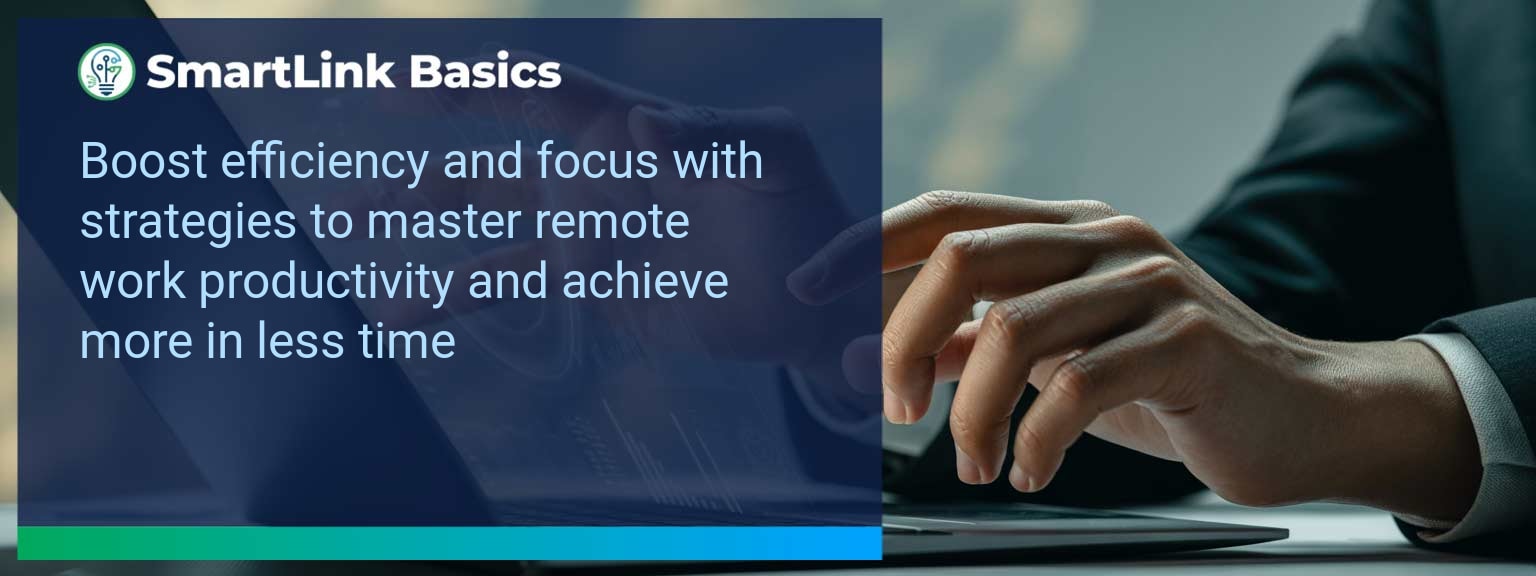Remote employees with a clear structure outperform peers by up to 40%, according to a 2024 Owl Labs study. For sales leaders managing distributed teams, this gap directly affects pipeline velocity and conversion rates. At SmartLink Basics, we see that cultivating a productivity-first mentality for remote workers is no longer optional—it is essential to sustaining competitive performance. This article outlines the key challenges, actionable strategies, and measurable frameworks leaders can use to ensure remote work productivity drives predictable revenue outcomes. You will learn how to diagnose performance blockers, apply focus strategies, and align virtual collaboration with your revenue system.
- Set measurable daily and weekly output goals with clear accountability
- Adopt structured time management and focus strategies
- Leverage AI tools to automate low-impact administrative work
- Implement an operating cadence that reinforces priorities
- Track leading and lagging indicators tied to revenue outcomes
Common Obstacles Remote Professionals Face in Achieving Productivity
Even high-performing remote teams often struggle with fragmented workflows. Distractions in home environments, inconsistent digital communication, and unclear expectations erode focus. Without physical proximity, the loss of organic peer accountability can slow decision-making. For example, a sales development team without defined pipeline checkpoints can waste hours on low-quality leads, reducing overall conversion efficiency. This type of inefficiency compounds over months, creating significant revenue leakage. Addressing these issues requires leaders to establish predictable frameworks that counteract the natural drift toward unproductive patterns.Effective Strategies To Enhance Output and Remote Work Productivity
A productivity-first approach begins with structural clarity. Leaders should revisit their ICP definitions, segmentation models, and targeting logic to ensure teams focus on the highest-value prospects. Structured operating cadence—daily stand-ups, weekly priority reviews, and monthly performance check-ins—keeps output aligned with business objectives. For example, teams using 15-minute virtual huddles each morning report higher call connection rates and better task completion timelines. Integrating time management tips such as the 90-minute deep work block, combined with collaborative tools for virtual collaboration, creates the right blend of focus and team cohesion. Leaders should also adopt AI-driven admin task automation to free capacity for higher-impact selling activities. These changes require intent but deliver quick returns, often visible in both work from home efficiency and deal cycle shrinkage within a quarter.Tangible Improvements In Performance With a Productivity-First Mentality
Sales leaders who institutionalize productivity checkpoints see measurable performance lifts. Tracking leading indicators like daily outreach volume ensures course correction before end-of-quarter pressure builds. Lagging metrics, such as closed-won rates, validate long-term alignment between activity and revenue. For instance, one enterprise SaaS team improved remote team performance by introducing automated call reviews and weekly deal strategy sessions, cutting average sales cycle length by 18%. By pairing quality metrics with activity tracking, leaders can accurately diagnose whether obstacles are capability gaps, focus issues, or structural misalignments. This diagnostic clarity supports proactive management.| Category | Metric | Definition | Target |
|---|---|---|---|
| Leading | Daily Outreach Volume | Number of prospecting actions per rep per day | 50+ |
| Lagging | Close Rate | Percentage of opportunities converted to wins | 25%+ |
| Quality | Opportunity Qualification Score | Weighted score based on fit and engagement | 80/100 |
Adapting For Long Term Remote Success
Long-term remote work productivity relies on leader adaptability. This includes evolving tech stacks, integrating new AI capabilities, and protecting work-life balance to avoid burnout. Teams that sustain performance over multiple quarters regularly reassess their operating cadence and redefine priorities as markets shift. A high-performing virtual sales force is built on continuous improvement cycles—capturing feedback, running small experiments, and scaling proven methods. Leaders who embed this iterative approach not only maintain current efficiency but also prepare their teams for competitive shifts. For deeper frameworks and advanced enablement tactics, consider reviewing the expert insights from SmartLink Basics to align operations for scalable growth. <Get the 90-day plan, coaching rubric, and dashboard template to operationalize AI in your enablement program.









